Haiti Journal: Part II
March 13Our quarters at Canaan are on the second floor above the crouche (pronounced “crush”). The crouche is where the babies are kept. I can hear one of them crying. The building is cinderblock with a tin roof. There are two sets of five steps, at a right angle to the door, which is a metal gate painted many colors and secured with a padlock. There is a screen door behind it. The railings and steps are also multicolored.Several Canaan students and Sister Gladys are there to greet us and help us carry our luggage inside. Several of our large suitcases are loaded with school supplies, games and treats for the kids – reams of lined and blank white paper, pencils, erasers, sharpeners, pens, markers, colored pencils, soccer balls, volleyballs, whiffle ball sets, bubbles, lollipops, granola bars, tooth brushes and toothpaste, and so on. Ricky says this is the only way to bring supplies to Canaan. Supplies shipped to Haiti will almost never arrive at the intended address.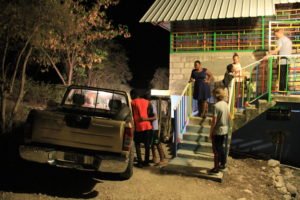 The building is open air, walls of screens allowing for good ventilation. There are three rooms, each with four sets of bunks, two bathroom areas, and a living area with a couch and chairs. Everything is clean, the beds made, mosquito nets tucked away, towels rolled up and resting near each pillow. As I tour the quarters, I notice that several large holes have been chewed into the screens. The holes are large, the size of a softball. Rats, I assume.The walls that divide the rooms rise about 7 or 8 feet. Enough to give you visual privacy. The ceiling sits another 5 to 7 feet above the top of the walls. The bathroom walls are lower than the walls in the bedroom, probably 6 feet, just high enough that you don’t have to duck to avoid being seen by someone in the other bathroom.I sleep on a top bunk right next to a large screen to make use of the breeze. I am in a room of my own and sweating as I climb into bed. Ricky, Shae, their nephew and children all share a second room.March 14I lie awake atop the covers much of the night. The squeaky fan overhead keeps me comfortable until sometime around 2am, when the generator turns off and the fan stops. Those awful and exaggerated thoughts that seem to accompany me on every trip to the developing world once again plague my mind – What if my appendix bursts? What if there is another earthquake? What if there is civil unrest on a large scale? Paranoia is difficult to remedy in the middle of the night. I make an effort to shut these thoughts down completely. Surprisingly, I am able to. Eventually, I fall back to sleep.Before sunrise, I hear people singing. Children’s voices, singing long and beautifully in Creole. Lying in the dark, listening to the angelic voices of children coming from somewhere down the mountainside, it seems as if I am in a dream. More people rise and sing from another part of the mountain, the adjacent village, it seems. Birds, dogs, roosters all contribute to the early morning bustle. Also in the adjacent village, a couple is awake and arguing about something.A nice breeze comes up the mountain as the sun warms the sky. I am comfortable lying there watching the sunrise, but by the time I slide down from the bunk and walk ten steps to the bathroom, sweat has beaded on my upper lip.Everyone else is awake and prepping for the day. I decide to freshen up before the day begins. The shower is a single spigot (narrow pvc pipe), which when turned on releases a small stream of cool water. After showering, we go for breakfast. I am sweating again before I even reach the cafeteria. Breakfast is eggs with onions and green peppers. Bread with peanut butter and marmalade. A banana. Scalding hot eucalyptus tea with sugar, which is delicious. When I finish, I am perfectly full.
The building is open air, walls of screens allowing for good ventilation. There are three rooms, each with four sets of bunks, two bathroom areas, and a living area with a couch and chairs. Everything is clean, the beds made, mosquito nets tucked away, towels rolled up and resting near each pillow. As I tour the quarters, I notice that several large holes have been chewed into the screens. The holes are large, the size of a softball. Rats, I assume.The walls that divide the rooms rise about 7 or 8 feet. Enough to give you visual privacy. The ceiling sits another 5 to 7 feet above the top of the walls. The bathroom walls are lower than the walls in the bedroom, probably 6 feet, just high enough that you don’t have to duck to avoid being seen by someone in the other bathroom.I sleep on a top bunk right next to a large screen to make use of the breeze. I am in a room of my own and sweating as I climb into bed. Ricky, Shae, their nephew and children all share a second room.March 14I lie awake atop the covers much of the night. The squeaky fan overhead keeps me comfortable until sometime around 2am, when the generator turns off and the fan stops. Those awful and exaggerated thoughts that seem to accompany me on every trip to the developing world once again plague my mind – What if my appendix bursts? What if there is another earthquake? What if there is civil unrest on a large scale? Paranoia is difficult to remedy in the middle of the night. I make an effort to shut these thoughts down completely. Surprisingly, I am able to. Eventually, I fall back to sleep.Before sunrise, I hear people singing. Children’s voices, singing long and beautifully in Creole. Lying in the dark, listening to the angelic voices of children coming from somewhere down the mountainside, it seems as if I am in a dream. More people rise and sing from another part of the mountain, the adjacent village, it seems. Birds, dogs, roosters all contribute to the early morning bustle. Also in the adjacent village, a couple is awake and arguing about something.A nice breeze comes up the mountain as the sun warms the sky. I am comfortable lying there watching the sunrise, but by the time I slide down from the bunk and walk ten steps to the bathroom, sweat has beaded on my upper lip.Everyone else is awake and prepping for the day. I decide to freshen up before the day begins. The shower is a single spigot (narrow pvc pipe), which when turned on releases a small stream of cool water. After showering, we go for breakfast. I am sweating again before I even reach the cafeteria. Breakfast is eggs with onions and green peppers. Bread with peanut butter and marmalade. A banana. Scalding hot eucalyptus tea with sugar, which is delicious. When I finish, I am perfectly full.
A Tour of the Campus and Clinic
We then walk down the path to observe the students of Canaan in their morning ritual. They file from the school and stand in lines to recite the Haitian pledge and the Christian pledge and raise the flags. The principal is a missionary from the state of Washington. Her name is Naomi. She inspects students uniforms as they enter the school. Certain kids, it seems, will sit out at recess due to uniform infractions. Principal Naomi is stern yet loving and reminds me of my elementary school principal, Sister Mary Victor, a nun whom I credit in part for instilling in me discipline, pride, respect.After the students go to class, we chat briefly with Principal Naomi then walk the property. The Canaan campus is lush in comparison with the adjacent villages, with hundreds of tall shade trees and a scattering of colorful bougainvillea. Lower down the hill the landscape opens up and the ground is mostly rock. Three women pass by, climbing the hill with large buckets of water balanced on their heads. Nearby, a thin horse forages for greenery on a mostly barren, shell rock hillside.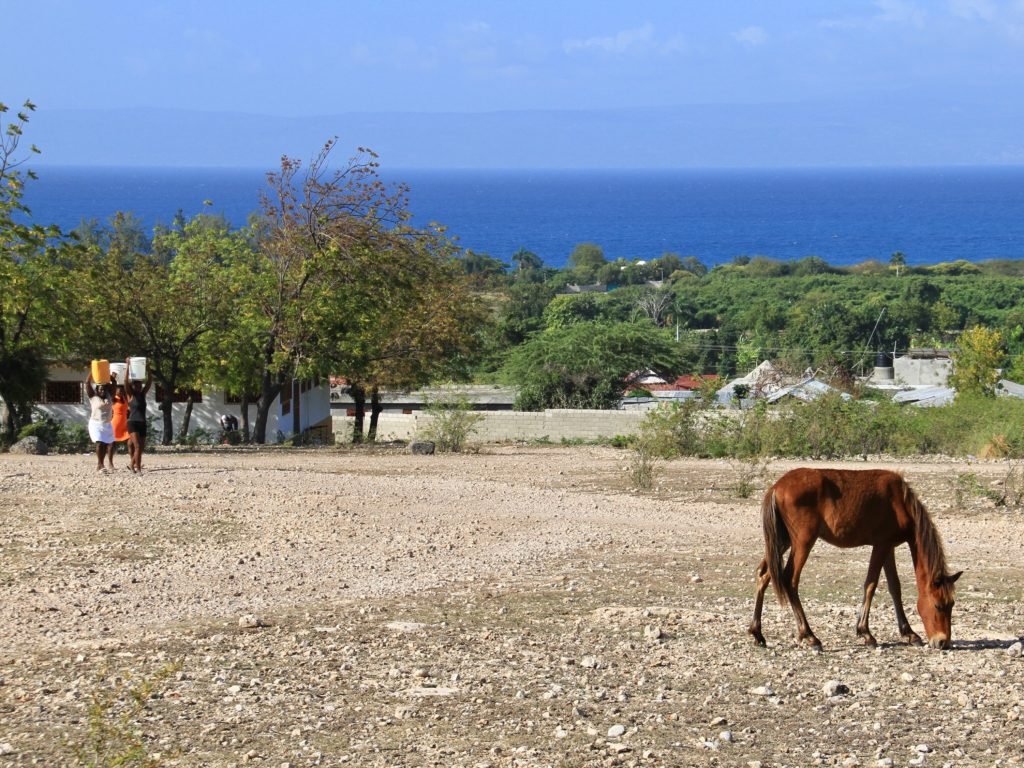 Just inside the entrance of Canaan, is the clinic. It is open to the public. Visitors pay a minimal fee, only if they can afford to. If they cannot, their service is free. A few people are gathered outside awaiting treatment. Shae has worked in this clinic many times before, but it is now fully staffed with Haitians. As we walk back up the hill, Shae tells me that the reddish tint you sometimes see in a child’s hair is a sign of malnutrition. Bloated bellies, too. When a body lacks protein and iron, the liver kicks into overdrive, building up fluid in the stomach, which causes the bloat.
Just inside the entrance of Canaan, is the clinic. It is open to the public. Visitors pay a minimal fee, only if they can afford to. If they cannot, their service is free. A few people are gathered outside awaiting treatment. Shae has worked in this clinic many times before, but it is now fully staffed with Haitians. As we walk back up the hill, Shae tells me that the reddish tint you sometimes see in a child’s hair is a sign of malnutrition. Bloated bellies, too. When a body lacks protein and iron, the liver kicks into overdrive, building up fluid in the stomach, which causes the bloat.
The Story of Chevy
Making our way back to office, I notice Pastor Henri exchanging a few words with one of the young boys, about 7-years of age. His name is Chevy. He smiles at whatever the Pastor says to him. Shae whispers to me that Chevy is one of the Pastor’s favorites. When Chevy runs off, Pastor Henri tells me his story.He opens by saying, “God opens doors.” As an infant, Chevy was dying of malnutrition. There is a charity that provides a supplement called Medica Mamba, a high-calorie, nutrient rich peanut butter, and Chevy was eligible. Members of this charity deliver the Mamba to those in need then check back on regular intervals to monitor progress. Chevy went through two cycles of Mamba, but when members of the organization went to see him, his weight had not changed. They assumed Chevy’s father, who had four older children, was feeding the supplement to himself and older children, leaving nothing for Chevy.When Pastor Henri learned of this he told members of the organization, “We want Chevy at Canaan and he’s not leaving.” Soon after, Chevy was brought to Pastor Henri. He was fed and cared for, but remained in poor condition. An x-ray revealed that Chevy had two kidney stones. He was not even a year old. He went for surgery, but the Doctor’s could only remove one of the stones. Chevy grew weaker and was very near death. They decided the only hope was to fly him to a hospital in Miami where he could have surgery to remove the second stone. Problem was, Chevy had no papers, no birth certificate.So Pastor Henri and Sister Gladys took Chevy to the embassy at Port-au-Prince where Sister argued with a man for five hours. Over and over she told the man she was not leaving until they had his papers. She kept to her word. Through contacts in the States, an American doctor arranged to have Chevy flown to Miami on a private jet. When he arrived at the hospital, the second stone was immediately removed. Chevy was kept at the hospital for an additional 4-months while he was fed and nursed back to health. When he returned to Canaan, Pastor Henri said, “He was big and healthy and smiled constantly. It was like he was happy to be alive.” From this point, I notice that what Pastor Henri said is true. Chevy wears a big smile constantly.We return to the cafeteria for lunch. Set out on the table are plates of cold cuts, peanut butter, marmalade and bags of sliced bread. Sitting atop the food is a plastic dome to keep the flies away. I make a peanut butter and marmalade sandwich. When I finish the first, I am encouraged to make a second, so I do.
Learning About My "Upgrade"
After lunch Pastor Henri says that he has a project in mind for us. The “new” cafeteria, which is adjacent the current cafeteria, has been under construction for 16 years and it is very nearly functional.We enter though a metal gate that serves at the door. The main room is spacious with tiled floors, colorful murals on the walls, metal beams and a tin roof. There are two small rooms in the back that will serve as the kitchen and pantry. The low ceiling over these rooms is cement and cracked in many places. A half dozen rusty copper wires jut from several different holes in the ceiling, intended, I assume, for light fixtures that will never be installed. As for the shape, or dimensions, the ceiling is what those versed in geometry would call an “irregular quadrilateral.” I had to look that up. In high school, I was no good at geometry.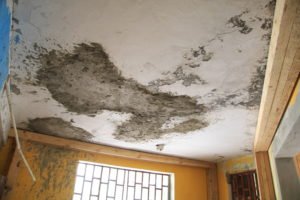 Pastor Henri says he would like us to install plywood and support beams on the ceiling to provide extra reinforcement and give it a nicer look.“I do not know when there will be another earthquake, but there will be one,” Pastor Henri says. “And when there is, I want the people working in here to be safe.”As he explains his vision for the ceiling, I worry that I will be able to contribute very little to this project. Construction is a skill set I do not possess. When the Pastor leaves, I say to Ricky, only half-jokingly, “Are you going to tell him there’s no chance of us pulling this off, or should I?” Ricky laughs. “I tell everyone that they get an upgrade when they come to Haiti,” he says. “If you screw in light bulbs at home, you’re a carpenter here. If you are a nurse back home, you’re a doctor here. I have faith we can figure this out.” Sadly, I’m a screw in the light bulb guy. Carpentry is a leap I don’t know that I can make.
Pastor Henri says he would like us to install plywood and support beams on the ceiling to provide extra reinforcement and give it a nicer look.“I do not know when there will be another earthquake, but there will be one,” Pastor Henri says. “And when there is, I want the people working in here to be safe.”As he explains his vision for the ceiling, I worry that I will be able to contribute very little to this project. Construction is a skill set I do not possess. When the Pastor leaves, I say to Ricky, only half-jokingly, “Are you going to tell him there’s no chance of us pulling this off, or should I?” Ricky laughs. “I tell everyone that they get an upgrade when they come to Haiti,” he says. “If you screw in light bulbs at home, you’re a carpenter here. If you are a nurse back home, you’re a doctor here. I have faith we can figure this out.” Sadly, I’m a screw in the light bulb guy. Carpentry is a leap I don’t know that I can make.
Playtime at Shae's Camp
After lunch I follow Shae, Ricky and their kids to the basketball court to help set up games and crafts. The younger elementary aged kids arrive as we are setting up and Shae shows them how to decorate visors. They write their names on the visors, draw pictures and affix stickers to them. Each of them is happy to show off their creative work. “Look at mine!” they say, holding out their visors for me to see. Visors done, we all blow bubbles and inflate a few beach balls that get batted and kicked around.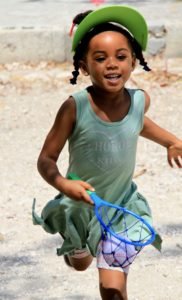 Next is a relay race involving a whiffle ball and paddle. With their newly decorated visors shading their faces, the kid's all shout and cheer and laugh throughout the race. Several try to cut line to get an extra turn. There is some shoving and elbowing and we try to restore calm by assuring them they’ll all get another turn.The middle and high school kids arrive and Shae transitions into different games in which they can all participate. But first, some jumping jacks and high knees to warm up the older kids. I join the exercise, thinking that I probably have not done jumping jacks since high school football practice, 26 years ago. After the first round I am drenched with sweat and out of breath and decide to sit out the second.Shae knows lots of games and runs the show at “camp.” Her cousin Jackson is a great help, as well. They have close to 50 kids in a perfect circle, all paying attention and participating. No small feat. I simply assist where needed, chat with the kids and take photos.There is one boy, a tall teenager, who is missing an arm. He has a very genuine smile and a kind way about him. I ask Shae about this boy. She tells me that he was trapped in the earthquake for several days before they found him. He was only six years old at the time. The scares on both sides of his face were left by the days he spent squirming back and forth in a desperate attempt to tear himself free. I assume his parents died in the quake, but I do not ask. It is hard to comprehend such a grim tragedy, yet the reality of it stands before me – a smiling teenager with one arm. I turn away, tears in my eyes, wondering what we are we to make of life’s boundless inequities. These circumstances are difficult, if not impossible, to reconcile.
Next is a relay race involving a whiffle ball and paddle. With their newly decorated visors shading their faces, the kid's all shout and cheer and laugh throughout the race. Several try to cut line to get an extra turn. There is some shoving and elbowing and we try to restore calm by assuring them they’ll all get another turn.The middle and high school kids arrive and Shae transitions into different games in which they can all participate. But first, some jumping jacks and high knees to warm up the older kids. I join the exercise, thinking that I probably have not done jumping jacks since high school football practice, 26 years ago. After the first round I am drenched with sweat and out of breath and decide to sit out the second.Shae knows lots of games and runs the show at “camp.” Her cousin Jackson is a great help, as well. They have close to 50 kids in a perfect circle, all paying attention and participating. No small feat. I simply assist where needed, chat with the kids and take photos.There is one boy, a tall teenager, who is missing an arm. He has a very genuine smile and a kind way about him. I ask Shae about this boy. She tells me that he was trapped in the earthquake for several days before they found him. He was only six years old at the time. The scares on both sides of his face were left by the days he spent squirming back and forth in a desperate attempt to tear himself free. I assume his parents died in the quake, but I do not ask. It is hard to comprehend such a grim tragedy, yet the reality of it stands before me – a smiling teenager with one arm. I turn away, tears in my eyes, wondering what we are we to make of life’s boundless inequities. These circumstances are difficult, if not impossible, to reconcile.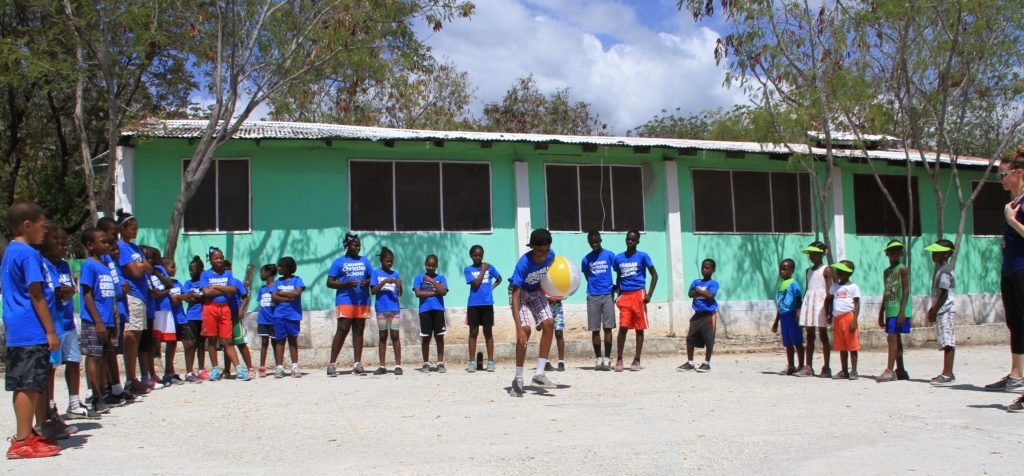 Ricky comes back from the office and asks me to join him on an errand. “We’re going into St. Marc’s to buy some wood for the ceiling,” he tells me. Soaking wet with sweat, I run to fill up my water bottle, then jump into the back of an idling pick up truck. Two locals sit up front. The driver is in his 20s, the passenger is probably 30-something. Neither speaks English. “Bonjour,” I say. They both nod and we begin our descent over bumpy terrain toward the interstate.The heat inside the truck is stifling and I roll down the window. As we turn onto the paved interstate, I begin to wonder how I’m going to manage my “upgrade” from a light bulb guy to a full-fledged carpenter.Visit the Canaan Christian School Website
Ricky comes back from the office and asks me to join him on an errand. “We’re going into St. Marc’s to buy some wood for the ceiling,” he tells me. Soaking wet with sweat, I run to fill up my water bottle, then jump into the back of an idling pick up truck. Two locals sit up front. The driver is in his 20s, the passenger is probably 30-something. Neither speaks English. “Bonjour,” I say. They both nod and we begin our descent over bumpy terrain toward the interstate.The heat inside the truck is stifling and I roll down the window. As we turn onto the paved interstate, I begin to wonder how I’m going to manage my “upgrade” from a light bulb guy to a full-fledged carpenter.Visit the Canaan Christian School Website
